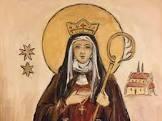
Feast day: 2 March
Agnes of Bohemia, born in 1211, was the daughter of King Ottokar I of Bohemia and a descendent of SS Ludmilla and Wenceslous, patron saints of Bohemia. St was also related to St Elizabeth of Hungary through her mother Constance. When she was three, she was entrusted to the care of St Hedwig, wife of Duke Henry of Silesia, who placed Agnes in a community of Cistercian nuns which she herself had founded. When she returned to Prague, Agnes went into a convent of Premonstratensian canonesses to continue her education.
At the age of eight Agnes was betrothed to Henry, son of Frederick II of Hohenstaufen, who had just been crowned King of the Romans, which was the title given to the Emperor’s heir. Normally she would have spent the time before her marriage at the court of her husband. Instead she went to the court of Duke Leopold of Babenberg. He wanted Henry to marry his own daughter. After six years the original marriage contract was cancelled, which angered Ottokar, so that he went to war with the Babenbergs. Ottokar then decided to marry Agnes to King Henry III of England but this was vetoed by the Emperor Frederick, who wanted to marry her himself. At this stage Agnes, tired of being a political pawn, decided to devote herself to prayer and good works and sought the help of Pope Greory IX. Emperor Frederick is said to have remarked:
“If she left me for a mortal man, I would have taken vengeance with the sword, but I cannot take offence because in preference to me she has chosen the King of Heaven.”
Agnes founded the Hospital of St Francis, on land donated by her brother King Wenceslaus I of Bohemia (c. 1232-33), and two friaries for Franciscan friars who had come to Bohemia at Wenceslaus’ invitation. Through them she heard of Clare of Assisi and began a correspondence, which led to Clare’s sending five nuns from the monastery in Assisi to begin a new house of the order in Prague. It was the first north of the Alps. Agnes built a monastery and friary complex attached to the hospital. This housed the friars and Poor Clare nuns who worked at the hospital. It was one of the first Gothic buildings in Prague. Agnes joined the Poor Clares herself in 1236. Here she cooked for and mended the clothes of paupers and lepers, even after becoming abbess of the Poor Clares the following year. The correspondence between Clare and Agnes displays the maternal fondness Clare felt for the latter, even though they never met.
Agnes organized a lay group in 1238, which became a new military order dedicated to nursing. It was known as the Knights of the Red Star and followed the rule of St Augustine. The next year Agnes handed over authority over the hospital to this order of monastic knights who were recognized by Pope Gregory IX in 1236-37. Agnes spent the rest of her life as abbess until her death in 1282.
The convent of St Agnes fell into disrepair after the Hussite wars and the community was abolished in 1782. It was restored in the 1960s and is now a branch of the National Gallery in Prague.
Agnes was canonized by Pope John Paul II in 1969. On the 800th anniversary of her birth, the Archbishopric of Prague in co-operation with the National Gallery organized an exhibition entitled St Agnes of Prague, princess and nun. It was held at the national cultural heritage site, the convent of St Agnes in the Old Town of Prague.
St Agnes of Bohemia, pray for us.